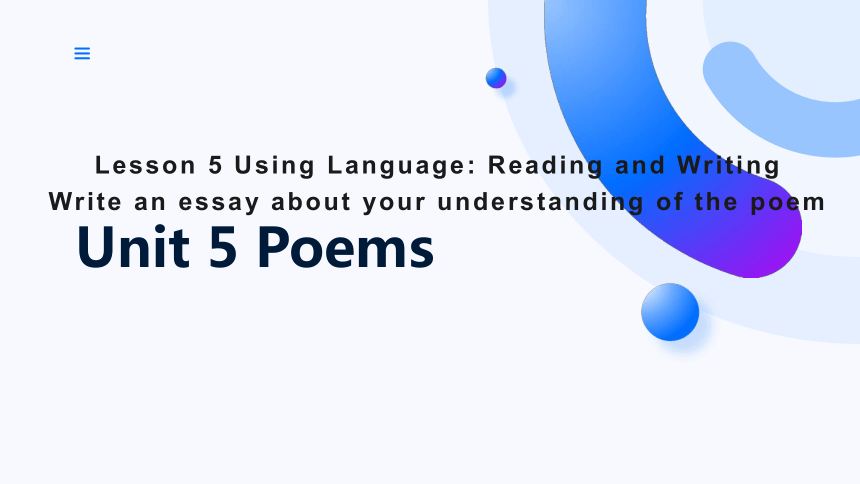(
课件网) Lesson 5 Using Language: Reading and Writing Write an essay about your understanding of the poem Unit 5 Poems In this lesson, you will 1. Read three poems and discuss how to understand a poem; 2. Read a sample short essay to further know how to understand a poem; 3. Learn to write an essay about your understanding of a poem; Learning objectives Discuss how to understand a poem with your partner. Make a list of questions that the readers should consider while reading poems. 1. What is the subject of the poem 2. What images(意象) does the poet use 3. What is the tone(基调) of the poem 4. Does the poem use rhyming words(押韵词) 5. How does the poem make you feel 6. What feelings and emotions does the poet try to convey 7. Which rhetorical devices (修辞手法)are used in the poem Before-reading We can understand a poem from the following aspects: 1. Subject/Topic 2. Images(意象) 3. Tone (基调) 4. Rhyming words 5.Feelings and emotions 6. Rhetorical devices(修辞手法):Metaphor(暗喻),Simile,(明喻)Alliteration (押头韵),Repetition (重复)... While-reading: Read three poems on P56 and discuss with your partner how to understand them from the following aspects. 1. Subject 2. Images 3. Tone 4. Rhyming words 5. Rhetorical devices 6. Your feelings and emotions 1.string: a strong thread used to fasten or pull sth or keep sth together 2. a broken-winged bird: a bird whose wings are broken 3. a barren field barren:not good enough for plants to grow on it 贫瘠的 4. frozen: (especially of ground) so cold that it become very hard 5. flowerful closes close: the area surrounding a cathedral(大教堂) From Oxford Advanced Learner’s English-Chinese Dictionary Nineth Edition Let's Read the poem together and undersand it from the aspects we mentioned. 1. Subject 2. Images 4. Rhyming words 5. Rhetorical devices 6. Your feelings and emotions 3. Tone the wind kite;the kid “I” childlike; showing child’s creativity and imagination knows/goes; can/ran; kite/night; blew/too; goes/knows repetition I feel like I am the child who is curious about the wind and trying to find out where the wind goes creatively Read the other two poems and then finish the excercise on P57 Wind on the hill Dream A Match Subject Images Rhyming words Rhetorical devices wind kite; “I” knows/goes; can/ran; kite/night; blew/too; goes/ knows repetition, dreams love a broken-winged bird, a barren field frozen with snow die/fly; go/snow rose, leaf, fields, closes together/weather; closes/is; grief/leaf repetition, metaphor, simile repetition, metaphor Read the sample short essay on P57 about how to understand a poem From what aspects “I” understand the poem Dream? Paragraph one The poem Dream by Langston Hughes is very short with only 8 lines. When I read the pome aloud I can hear that the ends of the second and fourth sentences rhyme-- “die” and “fly”. The last word from the sixth and eighth sentences also rhyme-- “go ... ...

